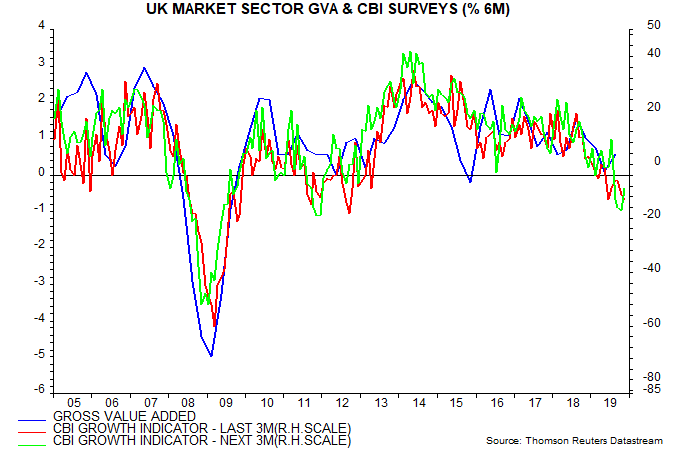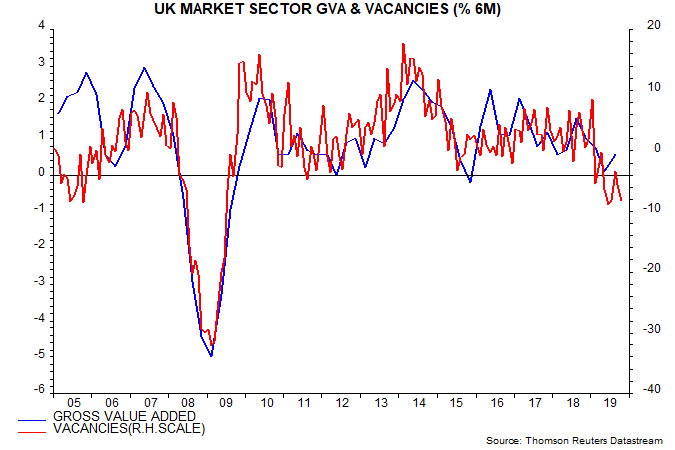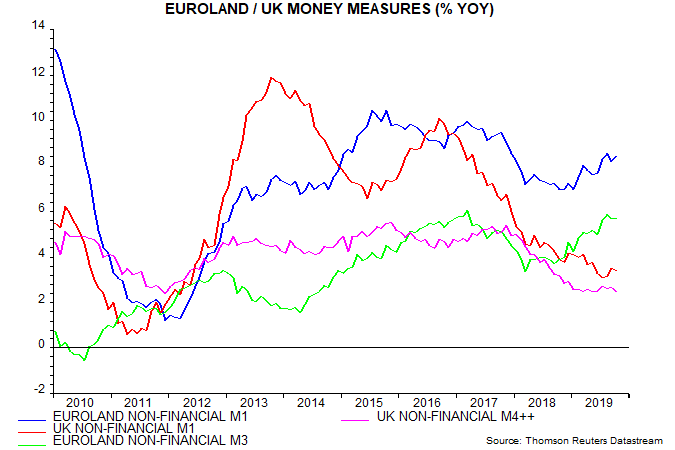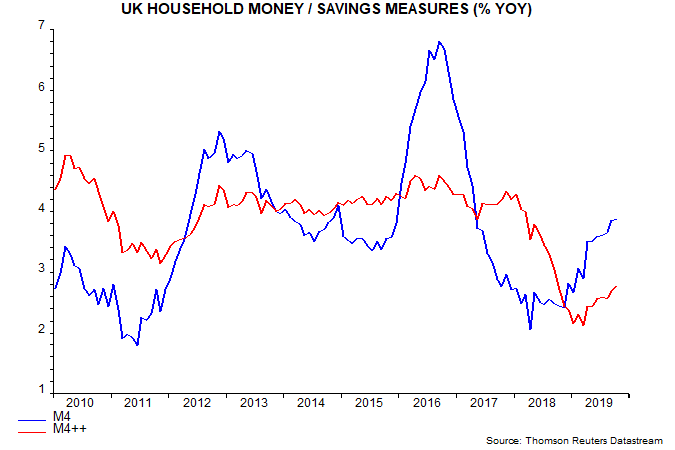Entries from December 1, 2019 - December 7, 2019
UK economy still stagnant / recessionary
UK monthly GDP / gross value added (GVA) for October will be released on 10 December, two days before the election. GDP is currently estimated to have fallen by 0.16% in August and 0.07% in September, with the September level 0.10% below the Q3 average.
October / November PMIs are consistent with economic contraction. So are the CBI’s past and future growth indicators, based on their monthly surveys of industry, distributive trades and services – see first chart.

Vacancies are a coincident indicator of GDP and have fallen this year at the fastest pace since the 2008-09 recession, also suggesting contracting output – second chart.

Monetary trends, meanwhile, remain weak. Annual growth rates of narrow and broad money have stabilised but are falling further below rising rates in Euroland – third chart. The UK economy has lagged in 2019 – GDP is currently estimated to have risen by 0.65% between Q4 2018 and Q3 2019 versus a Euroland increase of 0.86% – and relative money trends suggest a widening performance gap.

Within aggregate broad money, growth of household M4 holdings has recovered, leading some to suggest that consumer spending prospects are improving. This acceleration, however, mainly reflects a diversion of household savings from mutual funds to bank / building society accounts, which may signal rising risk aversion. Retail mutual fund inflows totalled £1.5 billion in the 12 months to September, down from £27.0 billion in the previous 12 months. Growth of an expanded measure of household money / savings incorporating mutual funds and National Savings (“M4++”) has risen by less and remains historically weak – fourth chart.

Global recovery not yet assured
Incoming news appears consistent with the assessment here that global industrial momentum bottomed in Q3 but will remain weak through Q1, at least.
The global manufacturing PMI new orders index recovered further in November but the current reading of 50.4 compares with a long-run average of 52.6 and suggests anaemic growth of industrial output – see first chart.

The PMI increase, moreover, was not mirrored by an alternative G7 plus E7 indicator that combines forward-looking components of national business surveys (ISM for the US, NBS for China, Ifo for Germany etc). This indicator bottomed in September but moved sideways below 50 in November – first chart.
Near-complete October monetary data, meanwhile, confirm that six-month growth of G7 plus E7 real narrow money slipped back to 2.3% from a downward revised 2.6% in September. This is above the range between December 2017 and August 2019, suggesting stronger economic momentum in mid 2020, but a rise through 3% is judged here to be necessary to confirm a “full” recovery later next year.
G7-only six-month real narrow money growth is above 3% (3.2%) but E7 growth remains well below (1.1%), mainly reflecting Chinese weakness – second chart.

As previously discussed, Chinese money trends lost momentum from Q2 as regional banking woes led to a tightening of credit conditions. Private firms still appear to be having difficulty accessing external finance: the corporate financing index component of the Cheung Kong Graduate School of Business survey weakened slightly further in November – third chart.

The global stockbuilding cycle probably bottomed in Q3 but a recovery may be delayed until H1 2020. While inventories have been slashed in some economies, notably Germany, the US is lagging (with the Q3 rise in inventories revised up last week) – fourth chart.

Recent weakness in US commercial and industrial lending, however, hints at a large stockbuilding drag on Q4 GDP – fifth chart.

The completion of German inventory adjustment could result in a rapid reconvergence of the country’s depressed manufacturing PMI with regional / global averages, a possibility also supported by the alternative Ifo survey – sixth chart.


